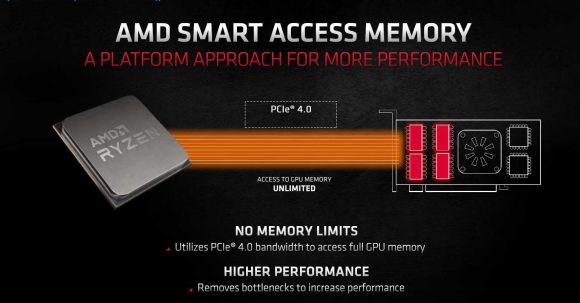AMD Radeon RX6000 – Part IV – Smart Access Memory – AMD Radeon RX 6800XT + AMD Ryzen 9 5950X
Source: Lab501 added 14th Dec 2020Smart Access Memory
Last week I told you about the excellent AMD Radeon RX 6800 XT and AMD Radeon RX 6800, two graphics cards through which AMD managed to return to competition in the high-end segment. This is due to a combination of factors, the main culprits being the optimizations brought at the architectural level, the use of a mature manufacturing process, the integration of technologies whose usefulness has been demonstrated in the processor segment (Infinity Cache) and nu why not access to funds R&D significantly higher than 2-3 years ago.
Of course, the list of news doesn’t stop there, with AMD implementing a number of new or significantly improved technologies, such as Radeon Anti-lag, Radeon Boost, FidelityFX Super Resolution, Variable Rate Shading or Smart Access Memory. We will discuss the latter today. Of course, you will probably wonder why we did not treat this topic from the beginning, respectively why we dedicate an entire article to it. Well, the answer just takes time.
You see, when I developed the new methodology for testing video cards, I tested 11 graphics cards, of these being models from the previous generation Nvidia and AMD, the eleventh being, obviously, RTX 3080. At that time, I was moving for the first time in the history of LAB 570 from an Intel platform 8700 K), which I have been using for two years, on an AMD platform, 3900 XT being at that time one among the best AMD processors.
Since then and until now, we have tested 4 new models (RTX 3090, RTX 3070, RX 6800 XT and RX 6800), as well as 9 implementations of graphics cards from the RTX series 3060, from various partners. Basically, in two months I tested 11 graphics cards, all on the new test platform, based on AMD Ryzen 9 3900 XT.
Well, Smart Access Memory is a technology that builds on the new AMD processors in the Ryzen series 5000, launched two weeks ago, together with an X chipset motherboard 570 and a graphics card from would be AMD Radeon RX 6000. Smart Access Memory offers the processor the ability to access the entire amount of VRAM memory, which normally has access only to 11 MB.
However, although AMD first implemented this feature on AMD RX series graphics cards 6000, the technology itself has been around for some time in the PCI-E specifications, with most motherboards having the two necessary options (Above 4G Decode and Resizable Bar Support) present in the BIOS. As a result, we may soon see this feature used by any CPU / GPU combination, whether we’re talking about AMD, Nvidia or Intel.
Until then, however, in order to benefit from this technology, we need an AMD processor from the Ryzen series 5000. As a result, to test this function, we had to use such a processor for tests, which means that we did not have to test only RX 6800 XT, with and without SAM activated, but also the main competitors, ie RTX 3080 and RTX 3090, thus preparing us for the launch of AMD Radeon RX 6900 XT. This means, in our case, 5 more sets of tests, in addition to the 3 prepared for the launch of RX 6800 XT, which was not possible in the context of time had available from the moment I received the samples until the launch. Moreover, we changed the test methodology for DXR games, retesting 5 Nvidia boards without DLSS, respectively testing 3 situations for AMD 6800, 6800 XT, 6800 XT Rage Mode) which also consumed time.
Last but not least, although we can’t wait to move on to a new methodology based on an AMD Ryzen series processor 5000, this will not happen this year, because new models will be launched from Nvidia and AMD, custom RX models will appear 6800 XT and RX 6800 and last but not least a whole series of new games have appeared and it is possible to replace 1-2 games in the current methodology with new titles . After most of the major releases (3060 Ti, 6900 XT) will take place, we will retest all the references from the AMD Radeon RX series 6000, respectively Nvidia GeForce RTX 3060 on a processor from the AMD Ryzen series 5000, we will add the new games, where appropriate and we will develop the video card testing methodology for 2021.
